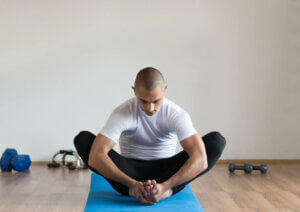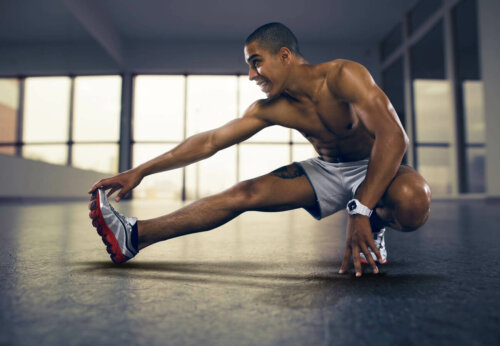The Importance of Stretching after a Workout

As children, most people are taught that stretching after a workout is essential. However, many don’t know exactly the reasons why this phase of training is so important.
In this article, we’re going to analyze the physiological reasons behind the importance of stretching after a workout. As you’ll see, doing so isn’t merely optional, but instead an essential way to preserve muscle condition.
Stretching before a workout?
Before we talk about the importance of stretching after a workout, we’re going to talk about stretching beforehand. In this case, it’ll only prove helpful if you’re going to do an exercise that involves stretching a muscle. In other words, if you practice rhythmic gymnastics, you definitely need to stretch before starting.
However, if you’re going to play a sport that requires strength, such as sprinting, it’ll be counterproductive. A study conducted by professionals from the European University state that it may not have any significant effects in other sports.
This is because the importance of warming up lies in preparing the body for what it’s going to have to do. People stretch to improve their flexibility. On the other hand, if you do muscle contractions during the warm up, you prepare your muscles to tighten.
Therefore, it isn’t always appropriate to stretch before playing sports. You can add a few movements to wake up and relax your body. However, it shouldn’t be the most important part of the warm up if you want strong muscle contractions.

Stretching after a workout
For its part, it’s always a good idea to stretch after a workout. The first reason why it’s important is to relax and loosen your muscles.
When you exercise or play a sport, you repeatedly contract your muscles. This means that, when the exercise is over, they remain tensed in case they have to keep contracting. When you stretch, you’re telling your muscles that they’re done, that they can finally relax.
When the muscles relax, they enter the recovery phase. Thus, the muscle fibers begin to regain the balance of substances that allow the contraction phase.
Therefore, this first reason is linked to the second: preventing contractures. If you don’t stretch and your muscle remains tightened, you’re much more likely to suffer a contracture. On the other hand, if you send the muscle a signal that it can now relax, the risk of contracture is much lower. However, other factors also play a role.
Thirdly, stretching after a workout is also good for flexibility. As scientific literature on this issue states, consistently stretching after exercising will help improve the flexibility of these muscle groups. It’s important to remember that this ability is necessary for proper bodily functioning, especially as we get older.
Blood and lactic acid
Another positive effect of stretching is that it improves blood circulation and oxygenation of the muscles. When the muscle fibers are tightened, they don’t get enough blood. Blood is important because, among other things, it carries substances that play a role in muscle recovery.
You want these substances to start working as soon as possible. If the blood that carries oxygen doesn’t irrigate the muscles, neither will these substances. When you stretch, the muscles relax and everything returns to normal.
Lastly, stretching after a workout is also important because it eliminates lactic acid. The muscles produce this substance when we exercise. However, afterwards, it causes muscle pain and fatigue. Stretching helps eliminate this substance, which promotes a faster recovery.

Take the time to stretch correctly
To conclude, we have to mention that, as a study published in the journal Physiotherapy states, there are many ways to stretch, and you must do so correctly.
For example, simply putting your foot behind your glutes doesn’t stretch the quadriceps well. You should also try to do an anterior pelvic tilt and bring your knee to the ground. You’ll notice that this stretch is a lot more intense.
Remember that the goal of stretching is to try to separate the origin and insertion of muscles as much as possible. It’s best if you do so actively. Regarding the previous exercise, you could support your foot with your hand but also push towards the glutes with your heel.
As you can see, the main function of stretching after a workout is to accelerate muscle recovery. When you exercise, you “damage” the muscles, and you must help them recover them as soon as possible.
Ultimately, stretching also helps improve flexibility and well-being. For all of these reasons, don’t ignore this phase of training. Learn to stretch correctly, and dedicate a few minutes of your workout to stretching. You won’t regret it!
As children, most people are taught that stretching after a workout is essential. However, many don’t know exactly the reasons why this phase of training is so important.
In this article, we’re going to analyze the physiological reasons behind the importance of stretching after a workout. As you’ll see, doing so isn’t merely optional, but instead an essential way to preserve muscle condition.
Stretching before a workout?
Before we talk about the importance of stretching after a workout, we’re going to talk about stretching beforehand. In this case, it’ll only prove helpful if you’re going to do an exercise that involves stretching a muscle. In other words, if you practice rhythmic gymnastics, you definitely need to stretch before starting.
However, if you’re going to play a sport that requires strength, such as sprinting, it’ll be counterproductive. A study conducted by professionals from the European University state that it may not have any significant effects in other sports.
This is because the importance of warming up lies in preparing the body for what it’s going to have to do. People stretch to improve their flexibility. On the other hand, if you do muscle contractions during the warm up, you prepare your muscles to tighten.
Therefore, it isn’t always appropriate to stretch before playing sports. You can add a few movements to wake up and relax your body. However, it shouldn’t be the most important part of the warm up if you want strong muscle contractions.

Stretching after a workout
For its part, it’s always a good idea to stretch after a workout. The first reason why it’s important is to relax and loosen your muscles.
When you exercise or play a sport, you repeatedly contract your muscles. This means that, when the exercise is over, they remain tensed in case they have to keep contracting. When you stretch, you’re telling your muscles that they’re done, that they can finally relax.
When the muscles relax, they enter the recovery phase. Thus, the muscle fibers begin to regain the balance of substances that allow the contraction phase.
Therefore, this first reason is linked to the second: preventing contractures. If you don’t stretch and your muscle remains tightened, you’re much more likely to suffer a contracture. On the other hand, if you send the muscle a signal that it can now relax, the risk of contracture is much lower. However, other factors also play a role.
Thirdly, stretching after a workout is also good for flexibility. As scientific literature on this issue states, consistently stretching after exercising will help improve the flexibility of these muscle groups. It’s important to remember that this ability is necessary for proper bodily functioning, especially as we get older.
Blood and lactic acid
Another positive effect of stretching is that it improves blood circulation and oxygenation of the muscles. When the muscle fibers are tightened, they don’t get enough blood. Blood is important because, among other things, it carries substances that play a role in muscle recovery.
You want these substances to start working as soon as possible. If the blood that carries oxygen doesn’t irrigate the muscles, neither will these substances. When you stretch, the muscles relax and everything returns to normal.
Lastly, stretching after a workout is also important because it eliminates lactic acid. The muscles produce this substance when we exercise. However, afterwards, it causes muscle pain and fatigue. Stretching helps eliminate this substance, which promotes a faster recovery.

Take the time to stretch correctly
To conclude, we have to mention that, as a study published in the journal Physiotherapy states, there are many ways to stretch, and you must do so correctly.
For example, simply putting your foot behind your glutes doesn’t stretch the quadriceps well. You should also try to do an anterior pelvic tilt and bring your knee to the ground. You’ll notice that this stretch is a lot more intense.
Remember that the goal of stretching is to try to separate the origin and insertion of muscles as much as possible. It’s best if you do so actively. Regarding the previous exercise, you could support your foot with your hand but also push towards the glutes with your heel.
As you can see, the main function of stretching after a workout is to accelerate muscle recovery. When you exercise, you “damage” the muscles, and you must help them recover them as soon as possible.
Ultimately, stretching also helps improve flexibility and well-being. For all of these reasons, don’t ignore this phase of training. Learn to stretch correctly, and dedicate a few minutes of your workout to stretching. You won’t regret it!
All cited sources were thoroughly reviewed by our team to ensure their quality, reliability, currency, and validity. The bibliography of this article was considered reliable and of academic or scientific accuracy.
- M. Gutiérrez, B. Novoa, M. Pérez et al. Propuesta de clasificación de las técnicas de estiramiento en fisioterapia. Fisioterapia. Volume 25, Issue 4, 2003, Pages 199-208
- Incidencia del estiramiento en deportistas de alto rendimiento. S. Núñez y A. Reshuán. Trabajo fin de grado para la Universidad Católica de Santiago de Guayaquil, 2015
- P. Sainz y F. Ayala. Efecto agudo del estiramiento sobre la agilidad y coordinación de movimientos rápidos en jugadores de fútbol de División de Honor. Kronos. Vol. 9, Núm. 17, 2010
This text is provided for informational purposes only and does not replace consultation with a professional. If in doubt, consult your specialist.








